0 Introduction
The 5th generation mobile network (5G) communication technology is increasingly applied for distribution network automation, distribution network protection, high-precision phasor measurement, intelligent inspection, and other applications [1, 2].It provides a novel development prospect for accurate fault location, isolation, protection, accurate load control, and real-time interaction of “distribution and power supply” side information in distribution networks.Simultaneously, under the background of “carbon peaking and carbon neutrality,” the large-scale two-way energy interaction of “distribution side-load side” transforms the form of intelligent distribution networks.The complex power flow environment makes distribution automation systems more dependent on high-reliability and low-delay 5G networks, and 5G networks are increasingly adaptedto satisfy the business requirements of the development of smart distribution networks, which effectively promotes 5G+new intelligent technologies that cannot be realized or are difficult to be popularized under prevailing communication conditions [1-3].Moreover, 5G networks have accelerated the upgrading and transformation of smart distribution networks.However, when implementing the large-scale application of 5G technology in intelligent distribution networks, the operation effects of the distribution network are not clear.As a result, researchers have been unable to gain a comprehensive and objective understanding of the 5G communication network’s operating effect of ascension for intelligent distribution networks, which limits the advancement of intelligent distribution networks.Therefore,a comprehensive evaluation of the large-scale application of 5G technology in smart distribution networks is particularly important.
Existing evaluation studies on smart distribution networks primarily focus on the economic evaluation of smart distribution networks [4], reliability evaluation [5],risk evaluation [6-8], effect evaluation [9], carrying capacity assessment [10], etc.There are few evaluation studies on the application of 5G communication technology in intelligent distribution networks.Reference [11]investigates reliability improvement of a cyber-physical system of the distribution network owing to the high efficiency of information transmission of the hybrid communication network and evaluates the reliability of an active distribution network.In [9], the implementation effect of an Internet of Things(IoT) smart distribution network based on the combined effects of 5G communication, artificial intelligence, and big data technology based on “cloud-tube-edge-terminal”is evaluated.References [12-14]primarily conduct comprehensive evaluations of smart distribution networks from multiple dimensions.Based on the existing analyses,a comprehensive evaluation and analysis of the largescale application of 5G communication technology in smart distribution networks is lacking in the literature.Concurrently, the evaluation indicators are limited by conventional evaluation approaches of smart distribution networks, and the degree of intelligence and efficient information interaction of 5G+ smart distribution network technology has been overlooked, which is not quite in line with the comprehensive evaluation of 5G+ smart distribution networks.
There have been some achievements in the research on the comprehensive evaluation of smart distribution networks.In [12], the combined weighting method combining the improved Analytic Hierarchy Process (AHP)and Criteria Importance Though Intercriteria Correlation(CRITIC) was adopted to determine the weights of evaluation indicators.Judgment matrices primarily rely on qualitative analysis, and as a result, there are uncertainties and ambiguities.In [15], a newly established Spherical Fuzzy Set (SFS) was combined with AHP for the first time,a language judgment scale based on SFS, enabling experts to freely express hesitation in the evaluation process.However,although the ambiguity of decision-making and subjectivity problems is averted, the calculation of subjective weights is complicated.In [14], a comprehensive evaluation model of a distribution network was developed based on interval intuitionistic fuzzy theory, and the validity of the evaluation results are confirmed by considering the uncertainty of the state information.However, the work lacks information on mining 5G+ smart distribution network node uncertainty.In summary, there is no relevant research on a comprehensive evaluation method suitable for the large-scale application of 5G technology in smart distribution networks.
Based on the above research background, we propose a comprehensive evaluation index system and comprehensive evaluation method in line with the 5G+ smart distribution network.First, the evaluation direction of this paper is as follows: reliable operation, economical operation, efficient interaction, technical intelligence, and green and low carbon;and the evaluation indicators are quantitative indicators.Second, to avoid the ambiguity, uncertainty, and difficulty of determining the weight of indicators in expert scoring,an improved Fuzzy Analytic Hierarchy Process (FAHP) is proposed for calculating the subjective weight, the objective weight is calculated using the entropy weight method,and the variance minimization principle is introduced to calculate the optimal combination weight.Moreover, a comprehensive evaluation model of 5G+ smart distribution network based on cloud model is proposed considering that the evaluation indicators contain uncertain information, such as distribution network nodes and equipment status.Finally,the 5G+ smart distribution network reconstruction project in a certain region of China is considered as an example to analyze the rationality and effectiveness of the evaluation model.
1 Application research of 5G communication technology in intelligent distribution networks
1.1 Demand analysis of an intelligent distribution network service for a 5G network
In the future, there will be more distributed pointto-point connections in the distribution network control service connection mode, and the master station system willgradually sink.There will be more nearby local control, and the demand for linkage with the main network control will reach the level of milliseconds.Moreover, the demand for reliability will increase to 99.999%.There will be a surge in the types of collection business, and the coverage will be increased by 50–100 times.For mobile application services,the communication rate of a single terminal is 50 Mbps.To facilitate such data rates, delays are required to reach tens of milliseconds.All these require the wireless private network to have ubiquitous access to massive terminals,and strong and reliable bearing capacity at low time,open and shared security management and control ability,efficient and flexible operation, and management ability.The characteristics of 5G communication technology,such as high speed, high capacity, high reliability, low delay, and low energy consumption, enable it to satisfy the requirements of various distribution network services in terms of network capacity, delay, bandwidth, security,and reliability.Consequently, 5G technology can promote innovative technologies that cannot be realized or applied using the existing communication technologies and standards.Additionally, 5G technology can form new business forms on distribution networks, improve the quality and efficiency of energy ecosphere, the transformation of business form, and ensure the independent and controllable security of power networks.Moreover, 5G network slicing can establish different networks based on different requirements [16], which effectively improves the work efficiency and resource utilization of the access network.Therefore, 5G technology can be used to integrate and develop the global smart distribution network.
Furthermore, the current power system communication network in power distribution network businesses is sufficient in terms of time delay, reliability, safety, and low maintenance requirements at higher stages; however, for smaller cost requirements, 5G can ensure the accuracy of the power distribution network business, speed, and realtime operation, which is more suitable for the distribution business of all types of scenarios, as depicted in Fig.1.

Fig.1 Comparison of communication network performance
1.2 Analysis of the role of 5G network in smart distribution networks
In terms of distribution automation, various faults such as short circuit and open circuit can occur in a distribution network.Therefore, the fault needs to be quickly located and isolated, which requires the characteristics of multiple time scales.For centralized distribution automation, the delay is required to reach the second level, while for distributed FeederAutomation (FA), the delay is required to reach the millisecond level.Owing to the low-latency characteristic of 5G technology, it can help delay the distribution automation requirements in a timely manner to detect abnormal data.Accordingly, collecting and transmitting the low latency status data of electricity equipment to the data center and in a timely manner to obtain the corresponding equipment operating instructions, and take corresponding measures to realize two-way information flow can reduce the loss of the power distribution network, improve the efficiency of monitoring and management.Consequently, it can realize real-time dynamic monitoring, protection, and control of distribution network.
Regarding distribution network state detection,although distribution network monitoring range is small, a micro synchronous phase angle measurement unit (micro-PMU) installed only on a small number of key areas can be used to monitor the fault problems of the distribution network.However, as the large-scale application of 5G communication technology in intelligent power distribution networks continue to expand, it will be possible to achieve comprehensive PMU monitoring.To monitor huge amounts of data, the communication technology needs to be efficient with low delays in transmission.High density 5G connections have the features of high capacity per unit area to support a large number of deployed intelligent measurement components, and it has high precision while supporting PMU lossless transmission of data.Accordingly,the analysis center can obtain all the PMU time-series data to conduct a more comprehensive analysis of the safety of the power distribution network., It can satisfy the monitoring requirements of the distribution network,realize the interconnection of power equipment information in a distribution network as well as the interconnection of power distribution and transformation devices.Moreover,the analysis center can monitor, evaluate, and even predict the health status of the distribution network in the future,ensuring the safe and reliable operation of the entire distribution system.
continue
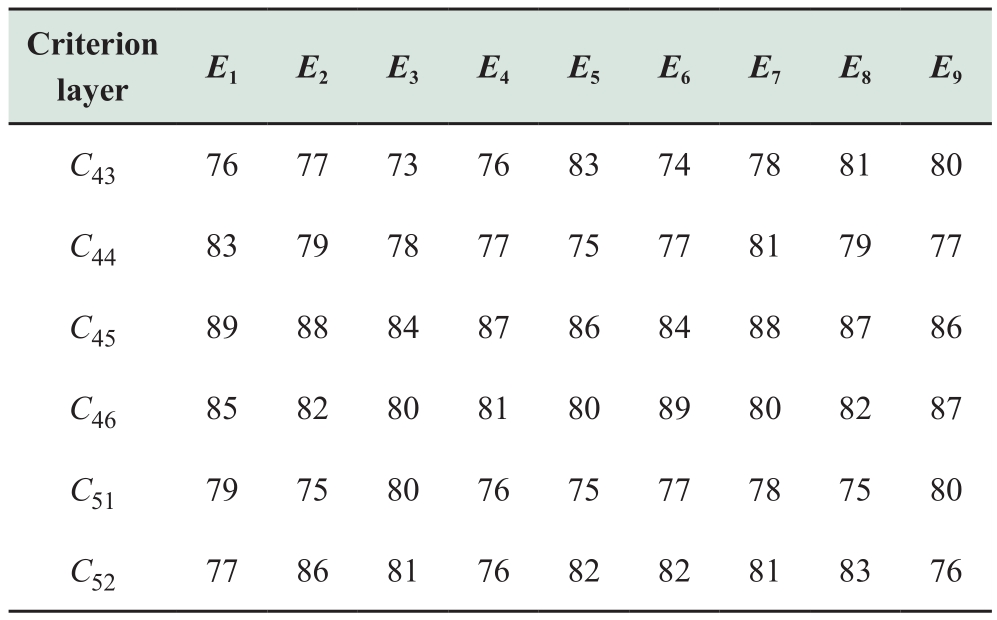
continue

continue

In terms of operation of distribution network protection,laying an optical cable along the configuration of differential protection methods are somewhat restricted,and fiber channels have lengthy construction periods, high costs, and require substantial investments.Besides, there are operational difficulties, low utilization rate of channel faults, delays in accurately using differential protection technology, and line fault isolation is absent, which affects the promotion and application of the differential protection in the distribution network.5G technology has low latency, making it suitable for highly reliable communication network simulation as a single line contact between the road ring network cabinet on both ends of the cable configuration, providing independently differential protection, measurement, and control, and merging one unit with more intelligent terminal devices, and USES the high precision time setting device for timing on both sides of the protection by establishing differential CPE 5G network access channel, realizing distribution network data interaction between multiple devices.Line protection device is fast and has reliable action, intelligent linkage control, and fault isolation.Simultaneously, the use of 5G technology can reduce cable laying, resource investments,fundamentally solve the problem of poor selectivity, and the low reliability of distribution network protection.Consequently, it would have better economic prospects,reduce the risk of external damage, and effectively enhance the reliability of power supply.
In terms of accurate load control of the distribution network, 5G network slicing is utilized to segment different services based on the demand, enabling accurate control of the load and electricity consumption can be guaranteed under different types of overload and overload faults occur.Additionally, based on the significance of electricity supply, the load priority hierarchies and sorting, even when an accident occurs in the load side, the system can accurately adjust to the load, which temporarily lowers priority industrial electricity supply, such as electric cars, factory internal charging pile, and power supply,prioritizing the important load of electricity.Based on different control requirements and time scales, combined with the characteristics and advantages of 5G networks,the power load of the user side can be changed quickly and accurately, so that the power supply and electricity of the power system can be balanced, and the risk of largescale power outage of the power system can be reduced to a certain extent, realizing the rapid load control millisecond time scale control system.Moreover, 5G communication can access massive devices, enabling accurate control up to the terminal equipment level, such as urban landscape lighting, air conditioning, etc., to achieve emergency load cutting without cutting off the feeder, which enables massive distributed resources to participate in the security and stability control of the system.
In terms of information exchange in distribution networks, the development of 5G communication technology enables users to obtain the electricity price and planned power outage information in real time.It helps them reasonably manage the use of electrical appliances.Additionally, operators can gain insights into the information of electricity demand on the user side in real time and realize the open sharing of supply and demand information,which is conducive to the optimization of power consumption by users.Concurrently, the high reliability and low delay characteristics of 5G are adopted to obtain power information to enable the distribution network to quickly grasp the power consumption characteristics of different users.First, the accurate identification of the dynamic topology and line parameters of the distribution network can be realized using the measurement data under the actual sampling frequency of smart meters, which conforms with the actual operation of the distribution network.Second,the traditional demand response primarily reduces the peakvalley difference on the demand side; however, with a high proportion of renewable energy connected to the grid, the dynamic demand response for shorter time scales, such as frequency modulation, can dynamically balance the power consumption behavior in real time.
2 Establishment of comprehensive evaluation indicators for 5G+ smart distribution network
Intelligent distribution networks with the large-scale application of 5G communication technology (referred to as the 5G+ smart distribution network) are based on the architecture of the intelligent distribution network and are supported by the 5G communication technology’s “high speed, high capacity, high reliability, low latency, and low power consumption.” Additionally, smart distribution network introduces new intelligent technologies adapted to the 5G network, upgrades the outdated distribution automation system, upgrades information collection and detection equipment, achieves reliable, economic, efficient,intelligent, and low-carbon development of the smart distribution network, accelerates the digital transformation of the distribution network, and seriously implements the“double carbon” goal.Accordingly, a new smart distribution network was formed with a high degree of integration of“energy flow, data flow, and business flow” [2, 3].
It is beneficial to promote the reliability of distributionnetworks.5G communication supports multi-terminal data interaction in the distribution network, supports longitudinal differential protection and regional protection control functions of the distribution network, realizes fast and accurate fault location and rapid self-healing in nonfault areas, shortens fault maintenance time, reduces the probability of large-scale power outages, and improves the power supply reliability of the distribution network.Simultaneously, 5G technology combined with DFACT5 and other technologies can solve various problems, such as transient power supply interruption, voltage harmonics,sag, imbalance, and other problems.In doing so, it can promote sustainable development and provide reliable power.Moreover, the precise load control at the millisecond level is adopted to minimize the impact on important users to avoid the expansion of the power outage range of users,and the non-important load that can be interrupted is cut out first to ensure the reliable operation of the entire distribution system.
It is beneficial to improve the economy of distribution networks.5G communication technology can be used to effectively monitor the real-time operation of networks and optimize management, improve the disaster recovery ratio and load rate of the system, fully exploit the system capacity, and reduce delays of the primary equipment of the grid, which creates significant social and economic benefits.Simultaneously, the low delay characteristic of 5G shortens the failure time, reduces the loss of the distribution network,improves the operation and transmission efficiency of the grid, reduces the operation cost, and promotes the efficient utilization of energy resources.
In fact, 5G technology is conducive to improving the efficiency of distribution network.The low delay and large broadband of 5G can be used to realize a two-way interaction of distribution network information and quickly locate and capture abnormal data in a timely manner.The inspection scope of lines and distribution rooms can be expanded to improve the inspection efficiency.Concurrently, 5G+ smart meters can enhance the two-way interaction efficiency between the distribution network and the user side by collecting power data from the demand side and distribution network giving instructions.Second,the low delay characteristics of 5G can effectively solve the communication delay problem of demand-side resources participating in real-time frequency modulation and improve the efficiency of real-time frequency modulation of demand-side resources, such as distributed energy storage and charging piles.
The operation of 5G has accelerated the deep integration of 5G and intelligent terminal equipment in distribution networks, improving the application level of intelligent technology and making the distribution network more intelligent.For instance, key technologies of smart distribution networks based on 5G communication technology include smart wearable devices, smart electricity meters, intelligent inspection robots, drones, etc.
The adoption of 5G technology is conducive to the low-carbon development of distribution networks.5G technology enables the distribution network access to a large number of DER, promote renewable energy development and utilization, reduce greenhouse emissions,and increase the proportion of clean energy in terminal energy consumption; thereby promoting environmental protection, energy structure, and production modes, to save a considerable amount of primary energy.Meanwhile,massive 5G base station energy storage can participate in the demand response of smart distribution networks, smoothen the consumption of renewable energy fluctuations, and improve the quality of power supply, effectively alleviating the problem of high carbon emissions and accelerating the realization of carbon emission reduction targets under the dual carbon background.
Based on the above characteristics of the 5G+ smart distribution network, namely reliable, economic, efficient,intelligent, and low-carbon operation, this study selects reliable operation, economic operation, efficient interaction,intelligent technology, and green and low-carbon as the evaluation direction, and establishes an indicator system, as illustrated in Fig.2.
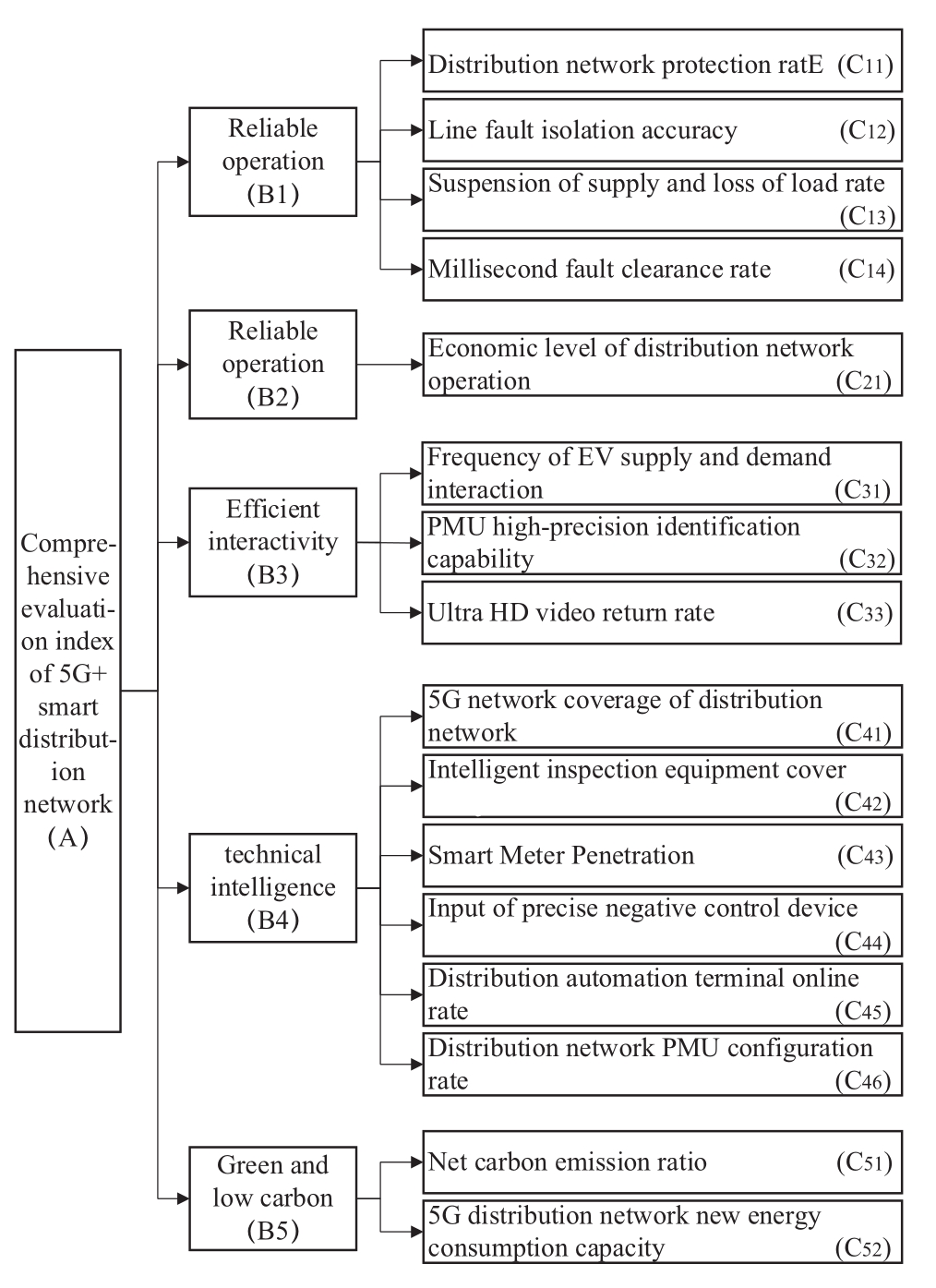
Fig.2 Comprehensive evaluation index of the 5G+ smart distribution network
2.1 Operational reliability index
The operation reliability index reflects the capacity of the 5G+ intelligent distribution network system to quickly diagnose, isolate, protect, and control during actual use.
1) 5G distribution network protection rate
The 5G distribution network protection rate reflects the capability of the distribution network system to operate continuously and stably, which is determined by the action time of the distribution network protection device installed on the 5G network channel.The 5G network channel protected by the distribution network can quickly transmit abnormal data, and try to avoid the refusal of the distribution network protection switch, failure of the action or failure to upload the control feedback information, which improves the performance of the distribution network protection action while shortening the failure time [17, 18], which is calculated as follows in (1).
where Tprotect denotes the actual normal distribution networkprotection action time within a certain monitoring period,andT indicates the total time of the monitoring period.
2) Line fault isolation accuracy
The line fault isolation accuracy reflects the ability of the 5G+ smart distribution network to accurately locate the fault point and quickly isolate the fault when a fault occurs in the 5G+ smart distribution network.The 5G+ precise positioning device promptly captures the abnormal current changes of the line and disconnects the circuit breaker in a timely manner to avoid the outage of the distribution network caused by the failure of faulty decision-making and the inability to accurately isolate a fault, and enhance the accuracy of line fault isolation.The calculation formula is given in (2).

whereλ i symbolizes the failure rate of the i-th fault type isolated in time, andλindicates the sum of the fault rates of all detected fault types.
3) The rate of supply and loss of load
The power loss and load loss ratios reflect the load loss ratio of the 5G+ smart distribution network that stops the power supply because of a fault.The calculation formula is given in (3).
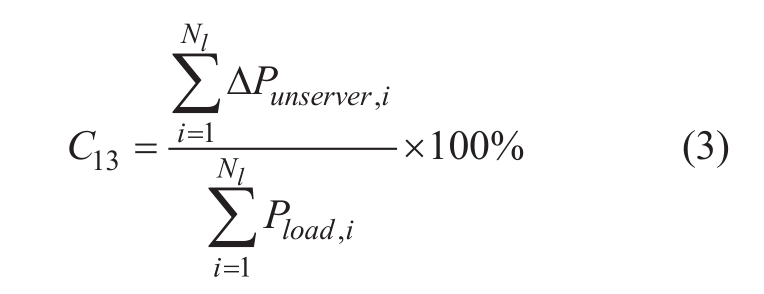
where i∈Νl, ∆Punserver,irepresents the active power of the i-th load node of the precise load control to stop the power supply, which represents the active power of the i-th load node of the precise load control, and Pload,i represents the load node set.
4) Millisecond-level fault removal rate
The millisecond-level fault removal time reflects the capacity of the 5G+ smart distribution network to quickly locate faults and remove faults within milliseconds.The calculation formula is expressed in (4).
where Tremove denotes the time elapsed from the occurrence of the fault to the successful removal of the fault.
2.2 Operational economic indicators
Operational economic indicators refer to the ability to reduce operating costs, system losses, and provide economic benefits following the upgrading of the 5G+ smart distribution network.
1) Economic level of distribution network operation
The economic operation level of the distribution network reflects the capability of the 5G+ smart distribution network to reduce operating costs and reap the corresponding economic benefits following the transformation.Among them, the cost input primarily includes the deployment of 5G operator frequency bands and core network investment costs, installation costs of new intelligent technologies,equipment costs, old equipment renovation costs, equipment or system failure maintenance costs, network loss costs,disposal costs of abandoned equipment, and the cost of abandoned wind and solar power generation.etc., and the calculation formula is given in (5) and (6).

where M denotes the total economic income of the 5G+smart distribution network in one year; Xi,n represents the discount coefficient; j denotes the annual interest rate of regular recovery;ni indicates the number of repayments forinvestment i;![]() represents the total annual investment cost of the 5G+ smart distribution network transformation project converted on an annual scale, including different types of costs, such as the annual 5G investment, annual equipment investment and transformation, annual failure maintenance, annual network loss, annual abandonment,and annual electricity abandonment costs.
represents the total annual investment cost of the 5G+ smart distribution network transformation project converted on an annual scale, including different types of costs, such as the annual 5G investment, annual equipment investment and transformation, annual failure maintenance, annual network loss, annual abandonment,and annual electricity abandonment costs.
2.3 Efficient interaction metrics
The efficient interaction index reflects the capacity of the efficient information interaction of the 5G+ smart distribution network to enhance the efficiency of the distribution network, including supply and demand interaction, data identification, and video backhaul efficiencies.
1) Frequency of EV supply and demand interaction
The frequency of the EV supply and demand interaction reflects the capacity of the 5G+ smart distribution network to frequently interact with electric vehicle charging stations.The calculation formula is expressed in (7).

where N denotes the number of times the EV charging station participates in the supply and demand interaction of the smart distribution network during the statistical period;tEVj indicates the time when the i-th charging pile participates in the supply and demand interaction; pj denotes the EV charging and discharging power.
2) High-precision identification capability of PMU nodes
The high-precision identification capability of PMU data reflects the capacity of the 5G+ distribution network PMU device to provide the system with high-precision, highresolution real-time measurements, and reduce the fault identification accuracy error [19].The calculation formula is given in (8).
where ΔUhigh-precision represents the minimum deviation of the voltage phasor parameters at both ends of the faulty line measured by the 5G+ distribution network PMU technology,ΔU represents the minimum deviation of the voltage phasor parameters measured on the actual faulty line.
3) Ultra-clear video return rate
The ultra-clear video return rate reflects the capacity of the 5G+ smart distribution network to return state monitoring and mobile terminal inspection video data.The calculation formula is expressed in (9).

where Vup and Vdown represent the upstream and downstream bandwidth of the video backhauled from the distribution network, respectively.
2.4 Technical intelligence indicators
The technical intelligence index reflects the intelligence of the 5G+ intelligent distribution network.The proportion of the coverage of 5G networks, equipment, and new intelligent technologies is proportional to the intelligence index.
1) 5G network coverage of distribution network
The coverage of 5G network is a requisite condition for the comprehensive upgrade of intelligent distribution network systems, equipment, applications, and technologies.The calculation formula is given in (10).
where Scover denotes the coverage area of 5G in a smart distribution network, and S indicates the area covered by all communication technologies of the smart distribution network.
2) 5G+ intelligent inspection equipment coverage
The coverage rate of 5G+ intelligent inspection equipment represents the coverage rate of 5G+ intelligent inspection robots, drones, and other equipment.The calculation formula is expressed in (11).
where Sinspection denotes the distribution line area that can be monitored, andSindicates the total coverage area of the distribution line.
3) 5G+ Smart Meter Penetration Rate
The penetration rate of 5G+ smart meters indicate the proportion of the energy range covered by 5G+ smart meters.The calculation formula is expressed in (12).

where Pi indicates the energy recorded by the first 5G+smart meter in the statistical time, MW;Pall−loadrepresents the total load energy on the user side.
4) Commissioning rate of precise load control device
The commissioning rate of the precise load control device refers to the level of the device being put into operation.5G+ precise load control can reduce the failure rate of the distribution network and enhance the power supply capacity of the distribution network [20].Thecalculation formula is expressed in (13).
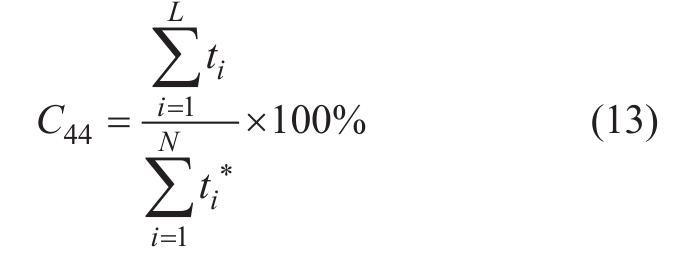
where ti indicates the commissioning time of the precise load control device of the i-th node,ti∗denotes the total running time of the i-th node, L indicates the number of nodes connected to the precise load control device, and N indicates the total number of nodes in the network.
5) Online rate of distribution automation terminal
The online rate of distribution automation terminals refers to the actual online work rate of distribution automation terminals with 5G channels installed.The calculation formula is expressed in (14).
where Nwideindicates the online number of the two remotes of the distribution automation switch, N refers to the total number of the two remotes of the distribution automation switch.
6) 5G+ distribution network PMU configuration rate
The PMU configuration rate of the 5G+ distribution network is determined by the number of PMU configuration nodes in the distribution network system.The increase of PMU configuration nodes can improve the redundancy of system measurement and improve the safety level of system operation [21].The calculation formula is expressed in (15).
where k denotes the number of 5G+ distribution network PMU configuration nodes, and N indicates the total number of nodes in the network.
2.5 Green and low carbon indicators
The green and low-carbon indicators reflect the degree of energy conservation, emission reduction, and new energy consumption of the 5G+ smart distribution network.
1) Net carbon emission ratio
Considering the different types of adjustable loads,such as charging stations, energy storage systems, and 5G base stations [22], which result in slight differences in carbon imbalance, it is impossible to accurately evaluate the impact of adjustable loads on carbon emissions following participation in demand response.Thus, this paper proposes the net emission ratio index to reflect the carbon emissions generated by the electricity consumption per unit load.The calculation formula is given in (16).
where Es, El, and Ec denote the electric energy transmitted to the distribution network by the superior substation, electric energy locally generated by the distribution network, and electric energy consumed by the load, respectively,τandµrepresent the proportion of new energy in the electric energy transmitted by the superior and locally generated,respectively, α and β symbolize the carbon-based electric energy transmitted by the superior and locally generated sources, respectively, and the carbon emission conversion factor.
2) New energy consumption capacity
The new energy consumption capacity flexibly reflects the 5G+ smart distribution network by adjusting the charging and discharging strategies of 5G energy storage[23], EV charging stations, and energy storage systems to enhance the new energy consumption capacity.The calculation formula is expressed in (17).

where Pi,t(NE) represents the active power actually consumed by the new energy of the i-th node at time t; Pi,t corresponds to the total active power of the i-th node, nNE represents the summary points of access to new energy, where t=1,2,…,24,∆t=1h.
3 Combined weighting method based on improved FAHP-EWM
From a subjective perspective, considering the difficulty of determining the index weight of the traditional subjective weighting method and the ambiguity and uncertainty of expert scoring [24], this study proposes an improved FAHP method to compute the subjective weight of the evaluation index.In terms of the objectiveness, this study employs the EWM method to determine the amount of information provided by each indicator via historical data.The combination of the two can consider expert experience and data objectivity.The optimal combination weight is obtained based on the idea of variance minimization.
3.1 Subjective weight model
Step1: Invite experts to score the fuzzy judgment matrix based on the scale in Appendix A, and use triangular fuzzy numbers [l,m,u]as the elements in the judgment matrix to reflect the uncertainty of the experts’ evaluation andjudgment, as illustrated in the following fuzzy judgment matrix:
where( )n×nis the fuzzy judgment matrix.mij indicates the relative importance of the two indicators given by the experts.Moreover, lij, uij represent the upper and lower bounds of the interval.Specifically, the larger the difference between
)n×nis the fuzzy judgment matrix.mij indicates the relative importance of the two indicators given by the experts.Moreover, lij, uij represent the upper and lower bounds of the interval.Specifically, the larger the difference between , the more ambiguous the expert’s judgment.
, the more ambiguous the expert’s judgment.
Step2: The consistency index CR is used for the consistency test [25]to verify whether the fuzzy judgement matrix conforms to the objective facts.Among them,CIRI = (β max −n) [( n − 1)RI ], and RI represents the average random consistency index.WhenCR<0.1,the pairwise comparison matrix passes the consistency test, otherwise it needs to be re-corrected.Following the consistency check, this paper introduces the max-min method to synthesize the scores of h experts into a unified result reduce the subsequent computational complexity.The aggregate value is calculated as follows in (19):

where  denotes the scoring matrix of the importance of ai relative to aj by the x-th expert,x = 1,2,...,h.
denotes the scoring matrix of the importance of ai relative to aj by the x-th expert,x = 1,2,...,h.
Step3: This study adopts an approximate matrix eigenvalue method that enables the synthesis of various opinions of experts, and normalizes the comprehensive triangular fuzzy numbers to obtain standard fuzzy weights.The calculation formula is given in (20):
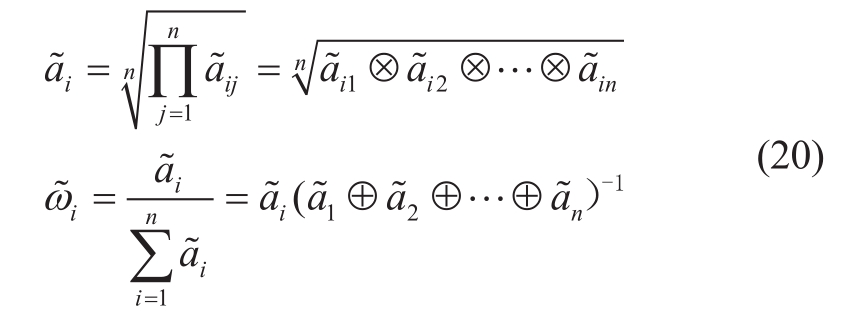
where  symbolizes the weight vector of the i-th indicator,and the fuzzy weight
symbolizes the weight vector of the i-th indicator,and the fuzzy weight![]() and the basic operations of the triangular fuzzy numbers are provided in Appendix B.
and the basic operations of the triangular fuzzy numbers are provided in Appendix B.
Step4: This study uses the optimistic index for defuzzification processing to apply the subjective weight value more intuitively.The calculation formula is as follows in (21):

where 0 ≤ α,β ≤1, andαindicates the expert’s preference coefficient, which represents the uncertainty of judgment.β denotes the risk bearing coefficient of the estimator, which represents the optimism of the estimator.This study selected α,β=0.5.
3.2 Objective weight model
Step1: To eliminate the inconsistency of benefit-type,cost-type, and interval-type indicators, it is necessary to normalize the indicators to obtain the evaluation matrix R=(rij)n×n, andi = 1,2,...,n,j = 1,2,...,n.
Step2: Find the characteristic proportion and entropy value:
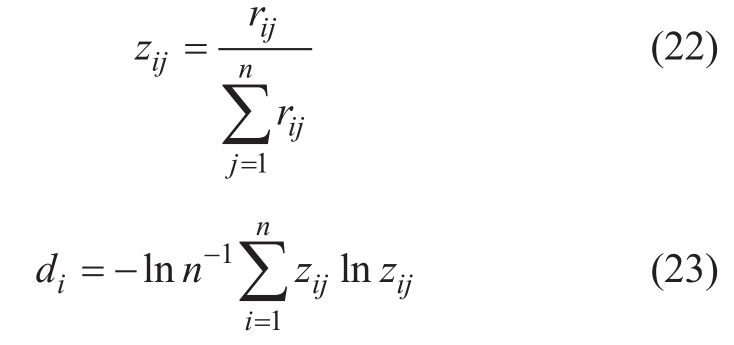
Step3: The objective weight value of the j-th indicator is:

3.3 Combined weight model
Step1: The linear combination weight W is obtained by the weighted combination of the subjective weight vector W1C and the objective weight vector W2C.Here, let the setWh =![]() we obtain the following formula in (25):
we obtain the following formula in (25):

where ξt symbolizes the combined weight coefficient of the t-th weighting method, and0 < ξ1 , ξ 2<1,ξ1 + ξ2=1.
Step2: To obtain the optimal combination weight coefficients ξ1and ξ2, this study introduces the idea of variance minimization to minimize the deviation between the linear combination weight W and the weight set Wh[6, 7, 12], and the optimal model is expressed as follows in (26):

Step3: The optimal first derivative condition is obtained from the differential property:![]() which is linearly transformed to obtain the following formula.
which is linearly transformed to obtain the following formula.

According to (27),ξ1,ξ2, and the combined weight value W can be obtained.
4 Comprehensive evaluation algorithm of 5G+ smart distribution network based on cloud model
5G+ smart distribution network is a system with a complex topology, diversified loads, and new energy access.However, its nodes, distribution network equipment status,user side, and other information are uncertain.The cloud model has certain advantages in describing the fuzziness and randomness in the above evaluation system [6, 7, 26, 27].The cloud model is based on the expected value Ex, entropy En, and super entropy He, which converts all index values n into (x1 , x 2 ,...,x n)cloud droplets to realize quantitative transformation into qualitative analysis.
Assuming that G is a quantitative domain represented by exact numbers, and C is a qualitative concept on G, if the quantitative valuex∈G, and x is a random realization of the qualitative concept Cx, then the normal random function satisfies![]() as follows in (28):
as follows in (28):
where Ex represents the value of qualitative concept;Eni s the measure of uncertainty of attribute concept;Heis the discrete degree of entropy.
4.1 Determination of cloud evaluation criteria
In this study, the entire score range of 0–100 is divided into 5 scoring intervals based on the rating level of excellent, good, medium, poor, and very poor, and then the cloud evaluation feature parameters![]() under this criterion are calculated according to the upper and lower bounds(E x , E n , H e)of the scoring interval.The calculation formula is expressed in (29):
under this criterion are calculated according to the upper and lower bounds(E x , E n , H e)of the scoring interval.The calculation formula is expressed in (29):

where e denotes a constant that can be adjusted according to the corresponding standard and actual situation [7, 25].This study selectse=0.5, and provides the cloud evaluation standards and cloud evaluation grades at different levels, as indicated in Table 1 and Fig.3:
Table 1 Characteristic parameters of cloud evaluation at different levels

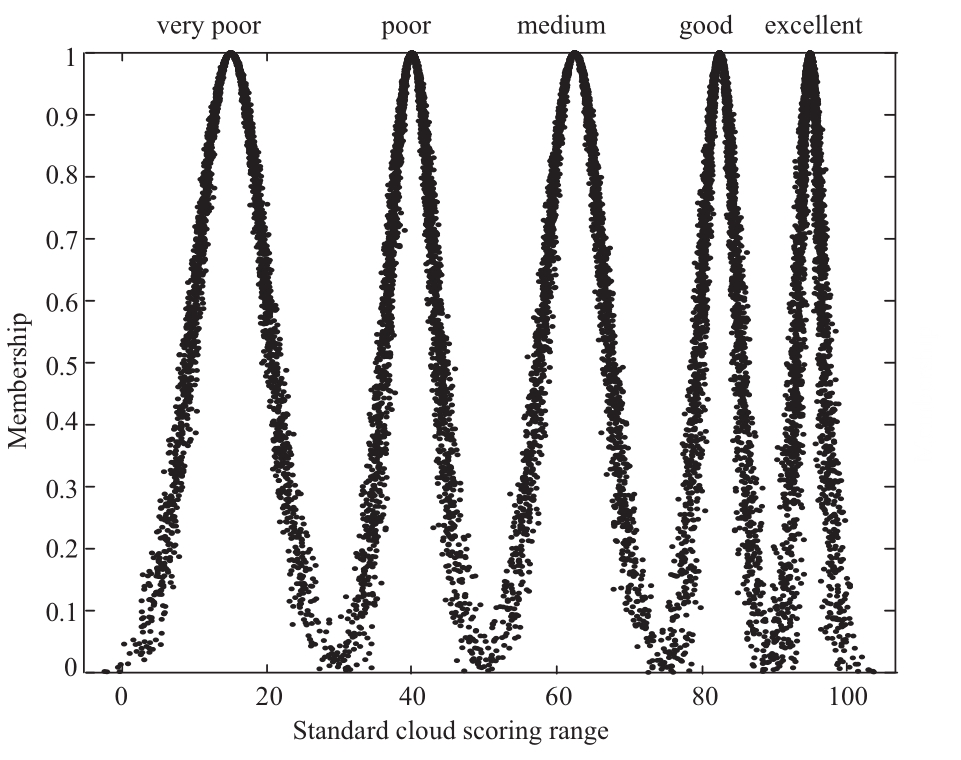
Fig.3 Cloud rating
4.2 Evaluation of cloud computing at criterion level and scheme level
In this study, m experts are invited to score the n indicators of the scheme layer, and the standard evaluation matrix  is constructed in the form of triangular fuzzy numbers, whereDm×nCis obtained by defuzzification with optimistic index, as shown below:
is constructed in the form of triangular fuzzy numbers, whereDm×nCis obtained by defuzzification with optimistic index, as shown below:

In the above formula, represents the scoring result for the n-th indicator by the m-th expert, and
represents the scoring result for the n-th indicator by the m-th expert, and![]()
The evaluation cloud digital feature of the i-th index of the scheme layer![]() can be obtained according to the scoring results.The calculation formula is expressed as follows in (31):
can be obtained according to the scoring results.The calculation formula is expressed as follows in (31):

where dpi denotes the evaluation of the i-th indicator by the p-th expert, andp =1,2,...,m,i = 1,2,...,n.
The calculation formula of the evaluation cloud digital feature ![]() of the f-th index of the criterion layer is expressed as follows in (32):
of the f-th index of the criterion layer is expressed as follows in (32):

where ωfisymbolizes the weight value of the i-th scheme layer indicator directly corresponding to the f-th indicator of the criterion layer, andi = 1,2,…,n,f =1,2,…,n.
To reflect the overall evaluation effect of the comprehensive evaluation of 5G+ smart distribution network, the cloud digital characteristicsR(E x , E n , H e)of the comprehensive evaluation can be calculated using (33):
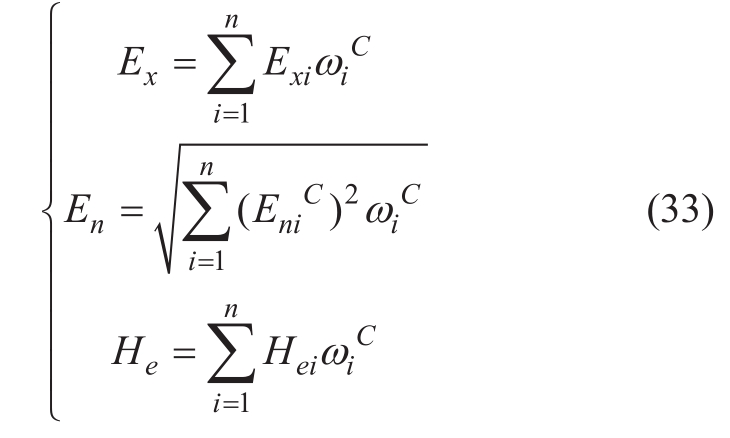
The comprehensive evaluation process of the 5G+ smart distribution network is illustrated in Fig.4.
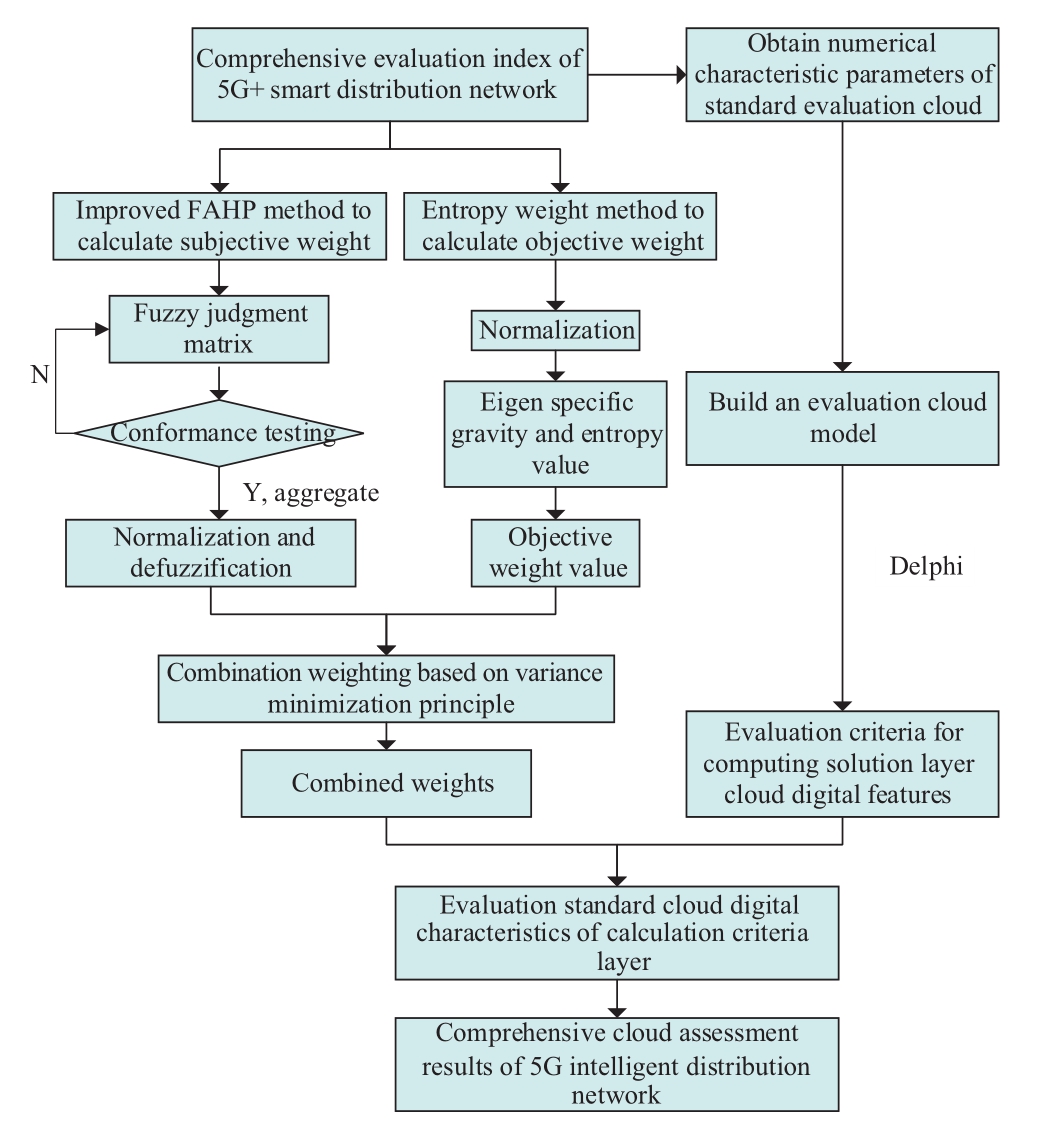
Fig.4 Comprehensive cloud evaluation flow chart of 5G+smart distribution network
5 Case study
As the analysis object, this study selects a 110 kV 5G+ smart distribution network reconstruction project in a certain region of China and refers to the relevant operating data and load-side data before and after the 110 kV 5G+smart distribution network upgrade and reconstruction,which are recorded as T1 and T2, respectively.Among them,T1 represents the situation where 5G technology is not applied in the smart distribution network.T2 represents the large-scale application of 5G technology in the intelligent distribution network, and only the weight calculation process in the case of subsequent display is shown, as listed in Table 2.
Table 2 Original data table in T1 and T2 cases

5.1 Indicator weight calculation
1) Use the improved FAHP method to determine the subjective weight.Nine experts were invited to score the criteria and scheme level indicators, and the scoring results of the experts were summarized according to (19).Owing to the limited space, this study only presents the fuzzy judgment matrix aggregation of the criterion layer and some scheme layers, as follows:


Similarly,![]() can be obtained.
can be obtained.
According to (20), all the matrices that have been checked for consistency are subjected to fuzzy normalization to obtain standard fuzzy normalization weights:

Similarly,![]() can be obtained.
can be obtained.
According to (21), the fuzzy weights are de-fuzzified,and the index weight vectors of the criterion layer and the scheme layer are obtained:

2) EWM calculates the objective weights.Based on(22–24), the indicator data are normalized and calculated to obtain the indicator weight vectors of the criterion and scheme layers:

3) Calculate the combined weights based on the principle of variance minimization.Substitute the subjective weight vector  and objective weight vector
and objective weight vector into(25–27) to obtain the optimal combination coefficients:ξ1 = 0.879,ξ 2=0.133, and the combined weight value of the criterion layer and the scheme layer, as listed in Tables 3 and 4:
into(25–27) to obtain the optimal combination coefficients:ξ1 = 0.879,ξ 2=0.133, and the combined weight value of the criterion layer and the scheme layer, as listed in Tables 3 and 4:
Table 3 Weight value of scheme layer combination

Table 4 Weight value of criterion layer combination

It is evident from Table 3 that the indicator C21 denotes the highest weight of the scheme layer, and its value is 0.113, which indicates that the 5G+ smart distribution network reconstruction project has high requirements on the operational economy.The weight value of the indicator C41 is 0.108, which ranks second in the scheme layer,indicating that the large-scale application of 5G in the smart distribution network should strengthen the coverage of the 5G network, which conforms with the development direction of the 5G+ smart distribution network, and the calculation of the weight is a follow-up evaluation for foreshadowing.
5.2 Comprehensive cloud evaluation results
To make the cloud evaluation results relatively scientific and reliable, we invited nine experts to score the schemelevel indicators according to the actual upgrading and transformation of the project, and de-fuzzy the scoring results to obtain intuitive values, as listed in Table 5.
Table 5 Comprehensive cloud evaluation table of the 5G+smart distribution network

According to formulas (31–33), the numerical characteristics of the criterion layer index cloud and numerical characteristics of the comprehensive evaluation cloud in the two cases of T1 and T2 are obtained, as listed in Table 6.Concurrently, the evaluation result map of criterion stratum cloud and comprehensive cloud evaluation result map under two conditions of T1 and T2 are given, as depicted in Fig.5–8.
Table 6 Comparison of the cloud evaluation results of the 5G+ smart distribution network in T1 and T2
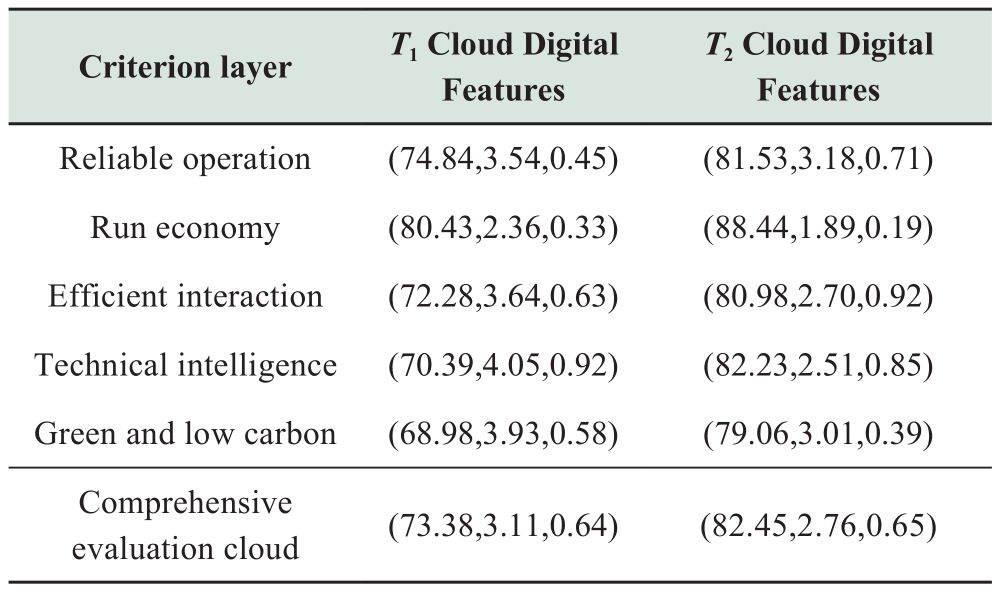
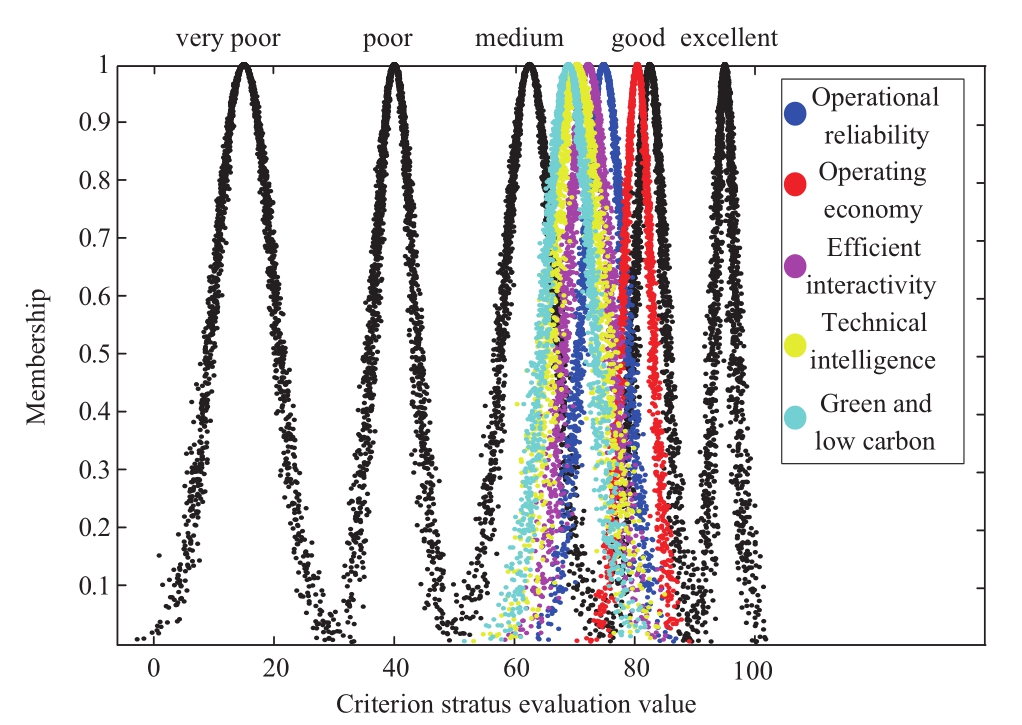
Fig.5 Evaluation results of the standard stratus cloud in T1

Fig.8 Integrated cloud evaluation results in T2
It can be observed from Fig.5 that the cloud evaluation values of various indicators in the criterion layer before the upgrade and transformation of the 5G+ smart distribution network are relatively low, among which the cloud evaluation values of green and low-carbon,technical intelligence, and high-efficiency interaction indicators are categorized under “medium” range but tend to be “good,” the reliability of operation belongs to the“moderate to good” range, and the economic indicators of operation belong to the “good” level, which indicates that the distribution network technology before the 5G transformation of the project is relatively immature.The 5G policy support is small, and the relevant supporting facilities are not perfect.Low sustainability and other development statuses have greater room for improvement.
As illustrated in Fig.6, criteria layer indicators after 5G+smart grid project transformation are better than those before the transformation, and some of these indicators in the cloud value belong to the “good” rating, where the efficiency index affiliated with “good” to “excellent” indicates improved performance in the following dimensions:reliable operation, economic operation, efficient interaction,technological intelligence, and green emission reduction.The results reveal that since the district is strongly invested in the construction of 5G, it prioritizes low-carbon and sustainable development, improves its own economy, and realizes the sustainable development of smart distribution network, which is safer, reliable, technologically intelligent,economical, and efficient.

Fig.6 Evaluation results of the standard stratus cloud in T2
It can be observed from Fig.7 and 8 that the comprehensive cloud evaluation results before 5G+ smart distribution network upgrade and transformation belong to the range of “medium” and “good,” and the comprehensive cloud evaluation results after the upgrade and transformation are“good,” indicating that the upgrading and transformation effect of the 5G+ smart distribution network project is good,and its overall operation effect has improved.

Fig.7 Integrated cloud evaluation results in T1
5.3 Comparison of evaluation algorithms
The present work aims to verify the rationality and effectiveness of the proposed combined weighting method based on improved FAHP-EWM.Accordingly,the data of the situation are utilized, the weights and evaluation results of the four weighting models are compared, namely EWM, AHP, improved FAHP, and improved FAHP-EWM (combined weighting method),and the weight results of different weighting methods are given, as presented in Table 7 and Fig.9.The comprehensive evaluation results of different weighting method models are listed in Table 8.
Table 7 Weight calculation results of different weighting methods
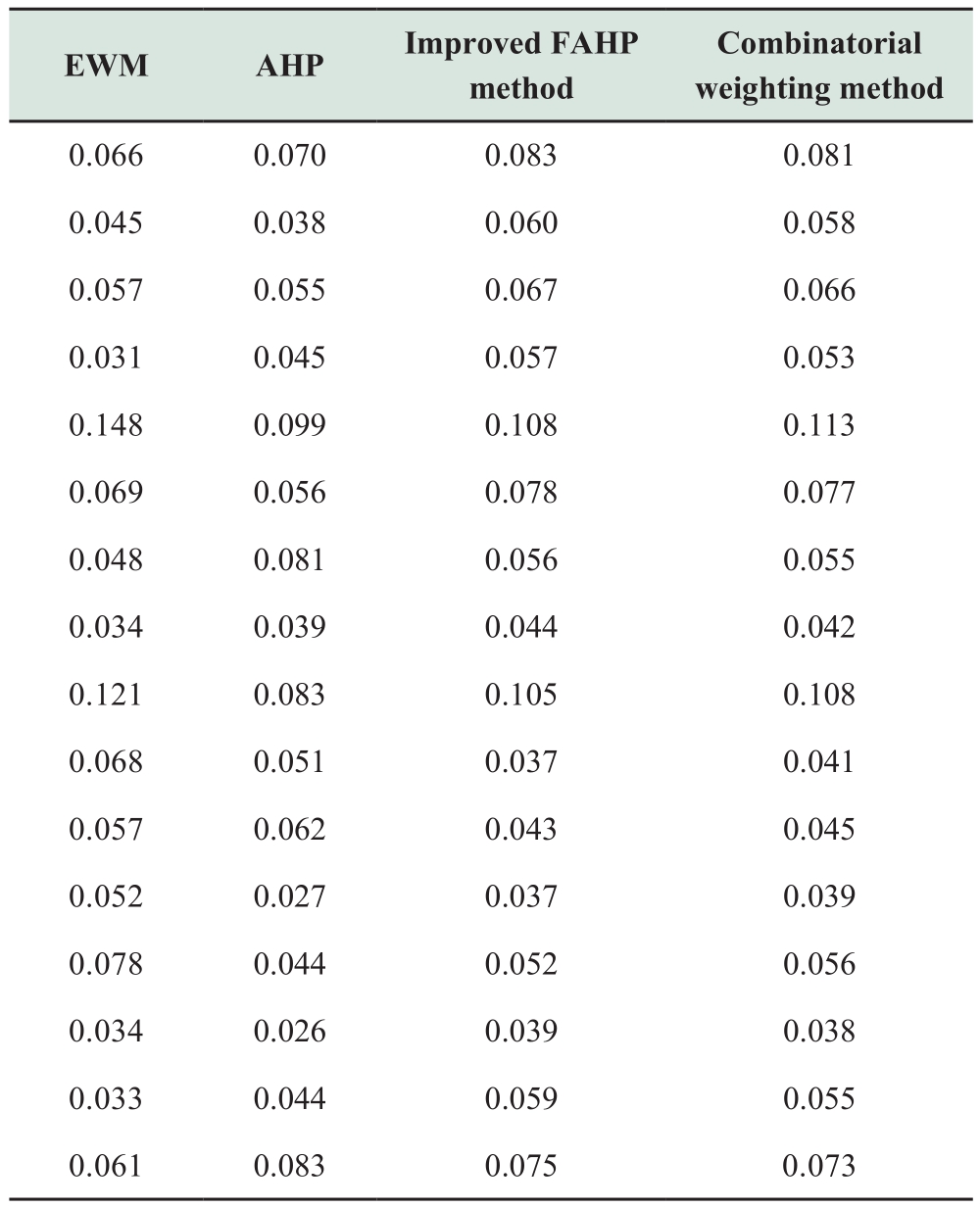

Fig.9 Comparison of weight results of different weighting methods
Table 8 Comprehensive evaluation results of different weighting methods
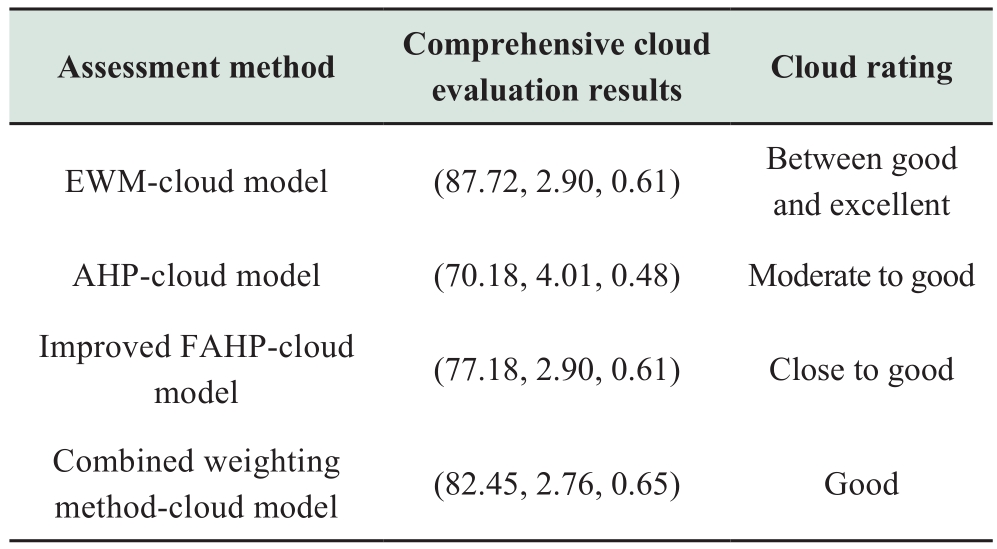
Table 7 and Fig.9 indicate that the weight obtained by the proposed combined weighting method is similar to the weight obtained by the other three weighting method models in the overall trend, and the index weight values are in between the minimum weight value and high weights.An alternative single empowerment method for calculation also played down the single method as being too subjective or objective when dealing with defects, highlighting that the empowerment of the proposed method is more stable and reasonable.
Table 8 indicates that according to the comparative test results of the first two groups, the single index weighting method is one-sided, and the evaluation results are likely to be inconsistent with the actual situation.Among them, the first group of evaluation grades belongs to the “good” and“excellent” range, the second group of evaluation grades belongs to the “medium” and “good” range, the evaluation results are relatively vague, prone to judgment errors.The third group improves the model based on the second group,although it is clearer than the second group, it cannot avoid the one-sidedness problem of the single weighting method.The fourth group is the combined weighting method-cloud evaluation model.This model can compensate for the limitations of the three different weighting methods, avoid the situation of over-poor or over-good evaluation, and obtain the evaluation results closest to the actual situation as far as possible, which can effectively enhance the evaluation accuracy.
Table A1 1-9 scaling
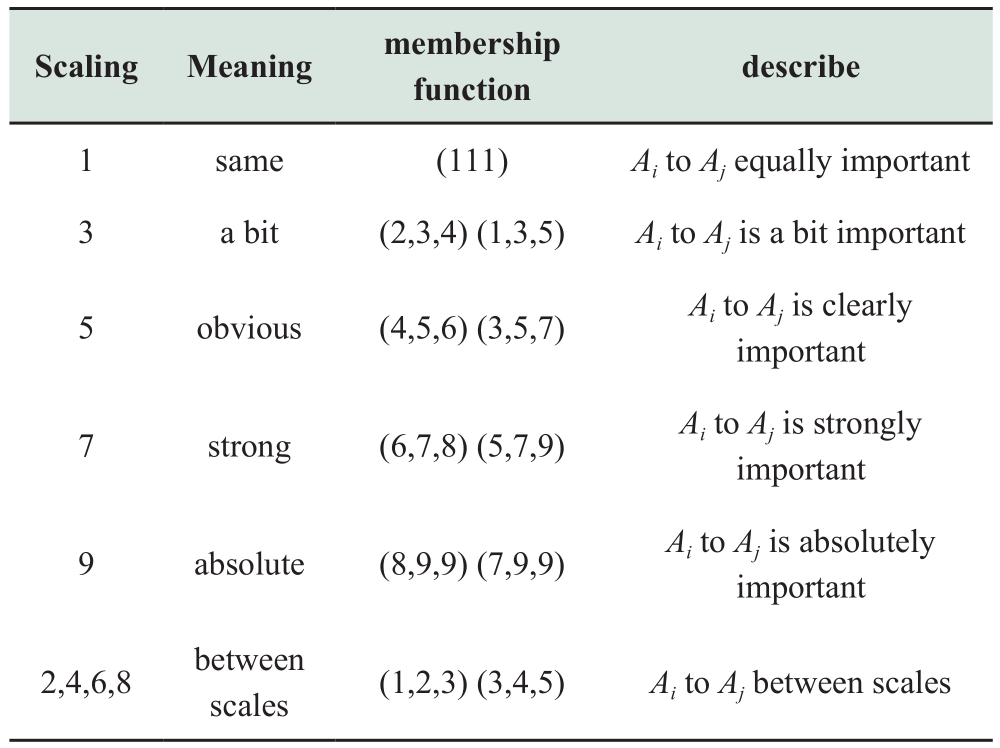
6 Conclusion
The operation effect of 5G+ smart distribution network is unclear following the transformation of 5G+ smart distribution network.This study aimed to deal with the problem by proposing a comprehensive evaluation method of 5G+ smart distribution network based on combination weighting and cloud model, aiming to comprehensively and reasonably understand the improvement in the overall operation effect of smart distribution network caused by the 5G communication network.The following results are obtained through case analysis:
(1) It effectively verifies the stability and rationality of the combined weighting method proposed in this study and can replace the single weighting method calculation while diluting the defects of the single weighting method that is either too subjective or objective, and the weight value calculated by this weighting method is more reasonable and accurate.
(2) Through case analysis, it is concluded that the upgrading and transformation effect of 5G+ smart distribution network project is good.Moreover, the 5G+smart distribution network has significantly advanced in terms of reliable operation, economic operation, efficient information interaction, intelligent technology, and emission reduction, which enhances the regional economy and alleviates the problems of 5G input cost and technology upgrade cost in the project.
(3) The stability and effectiveness of the proposed cloud model are verified by example analysis, which can avoid the situation of over-poor or over-good evaluation and can acquire the evaluation results closest to the actual situation as far as possible to effectively improve the evaluation accuracy.
The comprehensive evaluation method of the 5G+smart distribution network based on combined weighting and cloud model proposed in this study considers the impact of 5G technology on distribution networks, which has a guiding role for the large-scale application of 5G communication technology in future smart distribution networks.However, the input-output factors of the distribution network considered are not sufficiently comprehensive.In the future, the integration, planning, and research of smart distribution networks integrated with 5G technology will be extended to different aspects.
Appendix A
Appendix B
Suppose  and
and  are two triangular fuzzy numbers [23],the basic operations of triangular fuzzy numbers are as follows:
are two triangular fuzzy numbers [23],the basic operations of triangular fuzzy numbers are as follows:

Acknowledgements
This work was supported by the State Grid Corporation of China (KJ21-1-56).
Declaration of Competing Interest
We declare that we have no conflict of interest.
References
[1]Liu L, Qi B, Li B, et al.(2020) Requirements and developing trends of electric power communication network for new services in electric Internet of Things.Power Grid Technology, 44(8):3114-3130
[2]Zhou Z, Wang Z, Liao H, et al.(2022) 5G Cloud-edge-end collaboration framework and resource scheduling method in power Internet of Things.Power Grid Technology, 46(5): 1641-1651
[3]Zhang N, Yang J, Wang Y, et al.(2019) 5G Communication for the ubiquitous Internet of Things in electricity: technical principles and typical applications.Proceedings of the CSEE, 39(14): 4015-4025
[4]Xu B, Ma J, Chen Q, et al.(2019) Research on comprehensive evaluation index system and investment strategy of economic development zone distribution network based on improved AHPTOPSIS method.Power System Protection and Control, 47(22):35-44
[5]Ge S, Ji S, Liu H, et al.(2016) Reliability assessment of highmedium voltage level distribution networks based on cooperative analysis of multi-level networks.Transactions of China Electrotechnical Society, 31(19): 172-181
[6]Nan D, Wang W, Zhang L, et al.(2021) Risk assessment of the operation state of power grid secondary equipment based on association rule mining and combination weighting-cloud model.Power System Protection and Control, 49(10): 67-76
[7]He Y G, Liu J (2020) Electric Internet of Things security risk assessment based on combined weighting-cloud model.Power Grid Technology, 44(11): 4302-4309
[8]Chang Y, Liu C, Liu M, et al.(2019) Differentiation degree combination weighting method for investment decision-making risk assessment in power grid construction projects.Global Energy Interconnection, 2(5): 465-477
[9]Ge L, Li Y, Chen Y, et al.(2021) Key technologies of situation awareness and implementation effectiveness evaluation in smart distribution network.High Voltage Technology, 47(7): 2269-2280
[10]Zheng W, Zou B (2021) Evaluation of intermittent-distributedgeneration hosting capability of a distribution system with integrated energy-storage systems.Global Energy Interconnection, 4(4): 415-424
[11]Liu W, Gong Q, Guo J, et al.(2018) Reliability simulation of ADN cyber-physical system based on hybrid communication network.Proceedings of the CSEE, 38(6): 1706-1718+1907
[12]Luo N, He M, Gao H, et al.(2021) Comprehensive evaluation method for a distribution network based on improved AHPCRITIC combination weighting and an extension evaluation model.Power System Protection and Control, 49(16): 86-96
[13]Luo Z, Wei G, Yuan H, et al.(2019) Comprehensive decision of DC distribution network planning based on interval intuitionistic fuzzy theory.Transactions of China Electrotechnical Society,34(10): 2011-2021
[14]Song R, Ding J, Bai L, et al.(2017) Fuzzy comprehensive evaluation of distribution network based on cooperative game theory and trapezoidal cloud model.Power System Protection and Control, 45(14): 1-8
[15]Dogan O (2021) Process mining technology selection with spherical fuzzy AHP and sensitivity analysis.Expert Systems with Applications, 178: 114999
[16]Lu J, Luan W, Liu R, et al.(2018) Architecture of Distribution Internet of Things based on widespread sensing & software defined technology.Power Grid Technology, 42(10): 3108-3115
[17]Yu Y, Wang T, Xie M, et al.(2021) Research and application of intelligent distributed distribution network protection based on a 5G network.Power System Protection and Control, 49(8): 16-23
[18]Gao W, Gao H, Xu B, et al.(2021) Feasibility analysis of adopting 5G in differential protection of distribution networks.Power System Protection and Control, 49(8): 1-7
[19]Xu Q, Yuan Z, Lei J, et al.(2021) High precision synchronous phasor measurement and test method based on 5th generation mobile networks.Southern Power System Technology, 15(7): 76-80
[20]Huo C, Wang C, Tao D, et al (2020) Restoration strategy of distribution network considering precise load control.Power Grid Technology, 44(10): 4020-4028
[21]Tian S, Li K, Wei S, et al.(2021) Security situation awareness approach for distribution network based on synchronous phasor measurement unit.Proceedings of the CSEE, 41(2): 617-632
[22]Yong P, Zhang N, Ci S, et al.(2021) 5G communication base stations participating in demand response: key technologies and prospects.Proceedings of the CSEE, 41(16): 5540-5552
[23]Ma X, Zhu Q, Duan Y, et al.(2022) Optimal configuration of 5G base station energy storage considering sleep mechanism, Global Energy Interconnection, 5(1): 66-76
[24]Liu Y, Eckert C M, Earl C (2020) A review of fuzzy AHP methods for decision-making with subjective judgements.Expert Systems with Applications, 161: 113738
[25]Wu Y, Xu C, Zhang B, et al.(2019) Sustainability performance assessment of wind power coupling hydrogen storage projects using a hybrid evaluation technique based on interval type-2 fuzzy set.Energy, 179: 1176-1190
[26]Ma L, Zhang T, Lu Z, et al.(2022) Comprehensive evaluation of regional integrated energy system based on variable weight extension cloud model.Transactions of China Electrotechnical Society, 37(11): 2789-2799
[27]Zhang W, Wang L, Song R, et al.(2018) Comprehensive evaluation method of distribution network based on cloud model.Computer Engineering and Design, 39(7): 2096-2100
Received: 2 August 2022/ Accepted: 28 October 2022/ Published: 25 December 2022
Ying Wang
txcgdwy@163.com
Xiufan Ma
xfmhbdll@vip.sina.com
Zihao Liu
1318597593 @qq.com
Xiaoyu Feng
fengxiaoyu03@163.com
Biographies

Xiufan Ma received the B.S.and M.S.degrees in Electrical Engineering from Northeast Electric Power University, Jilin, China, in 1992 and 1995, respectively, and a Ph.D.degree in Electrical Engineering from North China Electric Power University, Beijing, China, in 2013.She is currently an Associate Professor with the School of Electrical and Electronic Engineering, North China Electric Power University.Her current major research interests include distribution network planning and operation, and electric vehicle planning and operation.

Ying Wang received the B.S.degree in Electrical Engineering from North China University of Water Resources and Electric Power, Zhengzhou, China, in 2020.She is currently working towards a Master’s degree at the School of Electrical and Electronic Engineering, North China Electric Power University, Beijing, China.Her research interests include the optimal configuration of smart distribution network, 5G new smart technology, and demand response.

Zihao Liu received the B.S.degree in Electrical Engineering from North China Electric Power University, Baoding, China,in 2020.He is currently working towards a Master’s degree at the School of Electrical and Electronic Engineering, North China Electric Power University, Beijing, China.His research interests include power system scheduling, and 5G new smart technology.

Xiaoyu Feng received the B.S.degree in Electrical Engineering from North China Electric Power University, Beijing, China,in 2020.She is currently working towards a Master’s degree at the School of Electrical and Electronic Engineering, North China Electric Power University, Beijing, China.Her research interests include the planning and analysis of intelligent distribution network integrating 5G network.
(Editor Yajun Zou)
